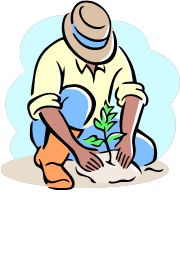 Transplanting Landscape Plants - June 19, 2013 Jeff Schalau, Agent, Agriculture & Natural Resources University of Arizona Cooperative Extension, Yavapai County People sometimes inquire about transplanting established landscape and garden plants. Transplanting success depends on many things, including: type of plant; how the plant was established (natural/native grown vs. planted by someone); how large the plant is (a tree vs. shrub or smaller); how well the plant can recover and regrow roots after transplanting; what type of irrigation it received before transplanting; the plant’s dormant period; and other factors. Herbaceous (non-woody) plants vary with respect to transplanting. Herbaceous plants with taproots often do not transplant well. A good example is California or Mexican poppy (Eschscholzia californica). These are best when grown from seed. Conversely, native perennial grasses can easily be moved and/or divided. You will be most successful if you move grasses during their season of growth, but before the plant has flowered. I’ve successfully transplanted lots of blue grama, buffalograss, and sand dropseed grass plants in my yard. Once established, native grasses are great at mitigating erosion and occupying spaces that would otherwise support annual weeds. Cacti and succulents are also easy to transplant and propagate from cuttings. Cacti should be transplanted during the growing season (summer). If roots are damaged, they should be pruned off and the wounds allowed to air dry and scab over for two or more days. Similarly, cactus cuttings should be allowed to air dry and scab over before planting. Many agaves produce “pups” which can be removed and transplanted. I have linked additional information on this topic below. Transplanting woody plants is a more complex matter. It depends in the size of the root system and how much of it is removed during transplanting. It also depends on the species of plant and how well adapted it is to your local climate. Native grown plants tend to grow large root systems and roots proliferate where they encounter favorable conditions. Plants adapted to disturbance, such as willows and cottonwoods, often grow a new root system after being disturbed by floods and debris flows. These plants can be transplanted but the feasibility is limited by the size of the tree. Both willows and cottonwoods can be grown from “pole cuttings”. Pine trees and many other coniferous evergreens are difficult to move because the roots may be growing further away from the trunk than other species. Conifers also keep their leaves and require water to support those leaves year round. If you dare to move a coniferous evergreen, always do it in the fall after temperatures are lower. This makes water demand lower and coincides with the tree’s least active period. Deciduous trees should also be transplanted in fall. Woody shrubs may be easier to transplant and have a higher rate of survival because the roots system is proportionally small. There are some general steps to follow when moving trees and shrubs. The first step is root pruning. Root pruning should started six months before the plant is to be moved. Begin root pruning by marking a circle the size of the desired ball around the tree or shrub, and then dig a trench just outside the circle. Backfill the trench with the removed soil, water the soil, remove air pockets, provide adequate moisture for new root development, then wait to transplant at the appropriate time of year. Before transplanting woody plants, tie up branches if necessary. Dig up the trench made six months earlier and try to minimize soil disturbance on the root ball. Larger plants may need a backhoe or other large equipment. Commercial operators often use a specialized tool called a tree spade. Either way, large root balls are very heavy. Have the planting hole ready to receive the plant and make sure the soil line remains the same in the planting hole as it was prior to transplanting. The hole should only be as deep as the root ball and the backfill should only consist of mineral soil. Irrigate all transplanted plants until they become established and longer if they and not drought adapted. One year is a common length of time to provide supplemental irrigation for reestablishment of transplants. Sandy soils are prone to fast drying and will require more frequent irrigation. Heavy soils are prone to poor drainage, so make sure not to overwater. Transplanted woody plants should be mulched to reduce soil evaporation and to keep the soil cooler. There is much more to know, so be sure to see the additional information on-line. Follow the Backyard Gardener on Twitter – use the link on the BYG website. If you have other gardening questions, call the Master Gardener help line in the Camp Verde office at 928-554-8999 Ext. 3 or e-mail us at cottonwoodmg@yahoo.com and be sure to include your name, address and phone number. Find past Backyard Gardener columns or provide feedback at the Backyard Gardener web site: http://cals.arizona.edu/yavapai/anr/hort/byg/. Additional Information and Photos How to Transplant a Cactus, University of Arizona Cooperative Extension http://cals.arizona.edu/pubs/garden/az1376.pdf Planting Pole Cuttings in Riparian Ecosystems, University of Arizona Cooperative Extension http://cals.arizona.edu/pubs/natresources/az1191.pdf Transplanting Established Trees & Shrubs, Clemson Cooperative Extension http://www.clemson.edu/extension/hgic/plants/landscape/shrubs/hgic1055.html Transplanting Trees & Shrubs, Cornell Cooperative Extension http://rocklandcce.org/PDFs/Horticulture_Fact_Sheet_205.pdf |